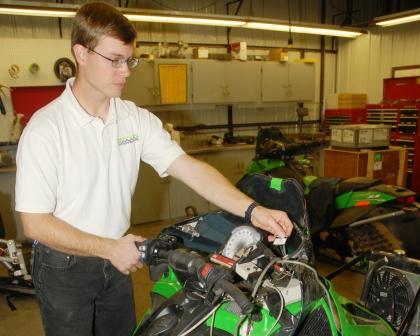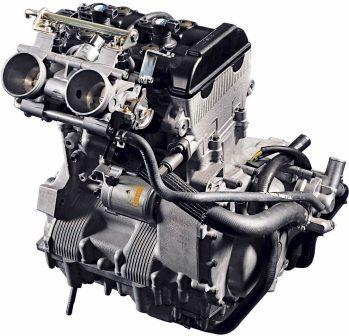
With the big buzz revolving around Arctic Cats 1100 4-stroke engines for 2012, I recently talked with Cord Christensen, Four Stroke Engine Group Leader at Arctic Cat, about the engine and some of the elements associated with it.
AI: Let’s talk about what is the break-in procedure of the 1100 4-stroke engine, and why it’s important.
Christensen: For the first 200-300 miles, you should keep the sled under 45 mph. Up to 500 miles, you should stay under half throttle, with limited WOT time. Short full-throttle bursts okay, for 5-10 seconds, but nothing longer than that.
Once the engine has reached 500 miles, it’s time for an oil and filter change, which will flush out contaminants that come from the manufacturing process. After this, you can run the engine however you desire.
The reason following this break-in procedure is so important is that the 1100 engine is manufactured with very tight tolerances, including the bearings on the crankshaft, connecting rods and wrist-pins. These elements need to wear-in a bit before the engine is fully-loaded, otherwise you can cause scoring on these bearings and surfaces.
After the initial oil change, we recommend oil/filter changes every 2,000 miles.
AI: Any difference in procedure between the 1100 Turbo and 1100 naturally-aspirated (NA)?
Christensen: It’s the same procedure.
AI: I have the perception that the 1100 engine “loosens up” after a few hundred miles. Is this accurate, or perception?
Christensen: A whole bunch of things happen to a snowmobile during the first few hundred miles: The track breaks in and becomes more pliable; the belt breaks in; the hyfax can develop a sort of hardening.
For the 1100 engine, the fuel injectors develop slightly greater flow during break-in, which will cause the engine to run a bit richer, plus the rings seat into the cylinders. And the oil begins to break down, which will “free up” the valve train slightly.
All of these factors together contribute to a freeing-up of the machine, which increases performance. I don’t have hard data on the process, so I can’t put a number to it. But the change is noticeable, and probably measurable.
AI: Why are there twin pipes on the 1100 for 2012, instead of the previous single pipe used in the Twin Spar chassis?
Christensen: The move to twin pipes was necessary because of the space limitations of the new chassis and hood combination. Other changes for 2012 compared to the previous version, is that it (the ’12 models) will be 2 decibels quieter, which is quite significant. This is the quietest engine/sled we’ve built, other than the T660 4-Stroke.
AI: I know that the F1100 showed around 15-18 mpg when ridden at normal trail speeds, and 12 mpg at wide open throttle. And I also know that on the same day these numbers were recorded, a 2011 Ski-Doo 600 E-Tec showed the exact same mileage. I think that these represent real-world mileage, and I scratch my head at some of the marketing claims I’ve seen from other brands.
Christensen: One thing to know is that there is no standardized testing methodology for fuel economy, so you have to take the inflated claims with a grain of salt. I also know that Arctic Cat riders who are coming of a 600 2-stroke will see a huge increase in fuel economy.
AI: I know you’ve done some acceleration comparisons between the 1100 in the ProCross chassis and the one in the Twin Spar chassis. What are you seeing in the field?
Christensen: The 2012 model consistently out-accelerates the 2011 version by 5-6 sled lengths. Once they move past the mid-range, both sleds show equal top speed as the 2012 preserves its initial gap.
We also ran the Ski-Doo 600 E-Tec in these same comparisons, and the 2012 F1100 constantly out-accelerated it.
AI: One of the big selling features of the 1100 4-stroke is its longevity compared to a 2-Stroke. If they operate the engine properly (correct break-in, no modifications, etc…), how many total miles can an owner expect from this engine?
Christensen: When we first developed this engine, we ran one test version up to 40,000 miles before we finally retired it. It went through three or four different chassis, and it could have kept going. I believe that with proper break-in and regular service, these engines could go 100,000 miles.
AI: What do you expect the aftermarket will come up with for the 1100 NA?
Christensen: I wouldn’t be surprised to see an exhaust system for it, something that would add around 4 hp, along with an increase in sound levels. But for riders who want an ultimate-performance 4-Stroke, the answer is to go with the Turbo.
AI: Any last points you’d like to make about the 1100 NA?
Christensen: The base engine hasn’t changed from what we introduced in 2007. It’s proven and reliable. I’m glad the new lightweight ProCross chassis is bringing the engine the attention it’s always deserved.
I think it’s also important to keep in mind that the F1100 runs on 87 octane fuel, doesn’t consume oil, comes with electric start, a heated seat and is priced in the middle of 600-class two-strokes.
